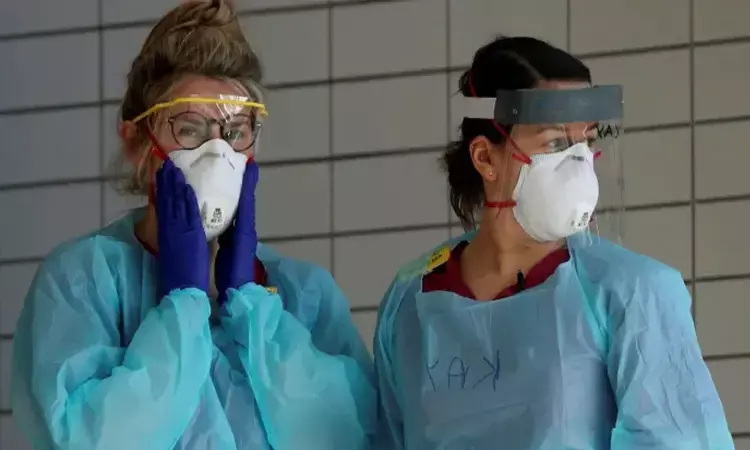- Home
- Medical news & Guidelines
- Anesthesiology
- Cardiology and CTVS
- Critical Care
- Dentistry
- Dermatology
- Diabetes and Endocrinology
- ENT
- Gastroenterology
- Medicine
- Nephrology
- Neurology
- Obstretics-Gynaecology
- Oncology
- Ophthalmology
- Orthopaedics
- Pediatrics-Neonatology
- Psychiatry
- Pulmonology
- Radiology
- Surgery
- Urology
- Laboratory Medicine
- Diet
- Nursing
- Paramedical
- Physiotherapy
- Health news
- Fact Check
- Bone Health Fact Check
- Brain Health Fact Check
- Cancer Related Fact Check
- Child Care Fact Check
- Dental and oral health fact check
- Diabetes and metabolic health fact check
- Diet and Nutrition Fact Check
- Eye and ENT Care Fact Check
- Fitness fact check
- Gut health fact check
- Heart health fact check
- Kidney health fact check
- Medical education fact check
- Men's health fact check
- Respiratory fact check
- Skin and hair care fact check
- Vaccine and Immunization fact check
- Women's health fact check
- AYUSH
- State News
- Andaman and Nicobar Islands
- Andhra Pradesh
- Arunachal Pradesh
- Assam
- Bihar
- Chandigarh
- Chattisgarh
- Dadra and Nagar Haveli
- Daman and Diu
- Delhi
- Goa
- Gujarat
- Haryana
- Himachal Pradesh
- Jammu & Kashmir
- Jharkhand
- Karnataka
- Kerala
- Ladakh
- Lakshadweep
- Madhya Pradesh
- Maharashtra
- Manipur
- Meghalaya
- Mizoram
- Nagaland
- Odisha
- Puducherry
- Punjab
- Rajasthan
- Sikkim
- Tamil Nadu
- Telangana
- Tripura
- Uttar Pradesh
- Uttrakhand
- West Bengal
- Medical Education
- Industry
Heating best method for disinfection of N95 masks, finds study

Researchers have revealed that heating was recently found to inactivate the coronavirus in solution within 5 min at 70 °C and is among the most scalable, user-friendly methods for viral disinfection of N 95 masks. Heating them preserves their filtration efficiency for 50 cycles of disinfection.The findings of the research have been reported in ACS Nano.
Scientists have been working on finding ways and means for disinfection of disposable N95 respirator masks amid shortages of personal protective equipment due to the Coronavirus Disease 2019 (COVID-19) pandemic.
A novel disinfection process appearing in Journal of the American College of Surgeons uses vaporized hydrogen peroxide for disinfection of disposable N95 respirator masks.
N95 masks contain a layer of "meltblown" polypropylene fibers that form a porous, breathable network. To help capture smaller particles that could slip through the holes, the fibers are electrostatically charged. The U.S. Centers for Disease Control and Prevention has recommended several methods for disinfecting N95 masks, such as heating, ultraviolet (UV) radiation and bleach treatment, but so far they have not been tested extensively, especially for multiple rounds of disinfection. Yi Cui and colleagues wanted to compare five of the methods that could reasonably be used within a hospital setting to see how mask materials hold up to repeated disinfections.
In this study, instead of analyzing N95 masks -- which should be reserved for health care workers -- the researchers examined pieces of the meltblown fabric used to make these masks. They treated the material with a particular disinfectant and compared its ability to filter aerosol particles (resembling respiratory droplets, but lacking coronavirus) before and after disinfection. The team found that spraying the fabric with an ethanol or chlorine bleach solution drastically reduced the filtration efficiency after only one treatment, from about 96% to 56% (ethanol) or 73% (bleach). A single steam treatment maintained filtration, but five steam treatments led to a sharp decline in efficiency. UV radiation allowed up to 20 cycles of disinfection; however, administering the exact dose of UV that kills the virus without damaging mask materials could be problematic, the researchers note. The best disinfection method appeared to be heating. For example, heating at 185 F for 20 minutes allowed the fabric to be treated 50 times without loss of filtration efficiency. But frequently donning and removing N95 masks could affect fit, which also impacts performance, the researchers point out.
For further reference log on to:
https://doi.org/10.1021/acsnano.0c03597
Dr Kamal Kant Kohli-MBBS, DTCD- a chest specialist with more than 30 years of practice and a flair for writing clinical articles, Dr Kamal Kant Kohli joined Medical Dialogues as a Chief Editor of Medical News. Besides writing articles, as an editor, he proofreads and verifies all the medical content published on Medical Dialogues including those coming from journals, studies,medical conferences,guidelines etc. Email: drkohli@medicaldialogues.in. Contact no. 011-43720751


